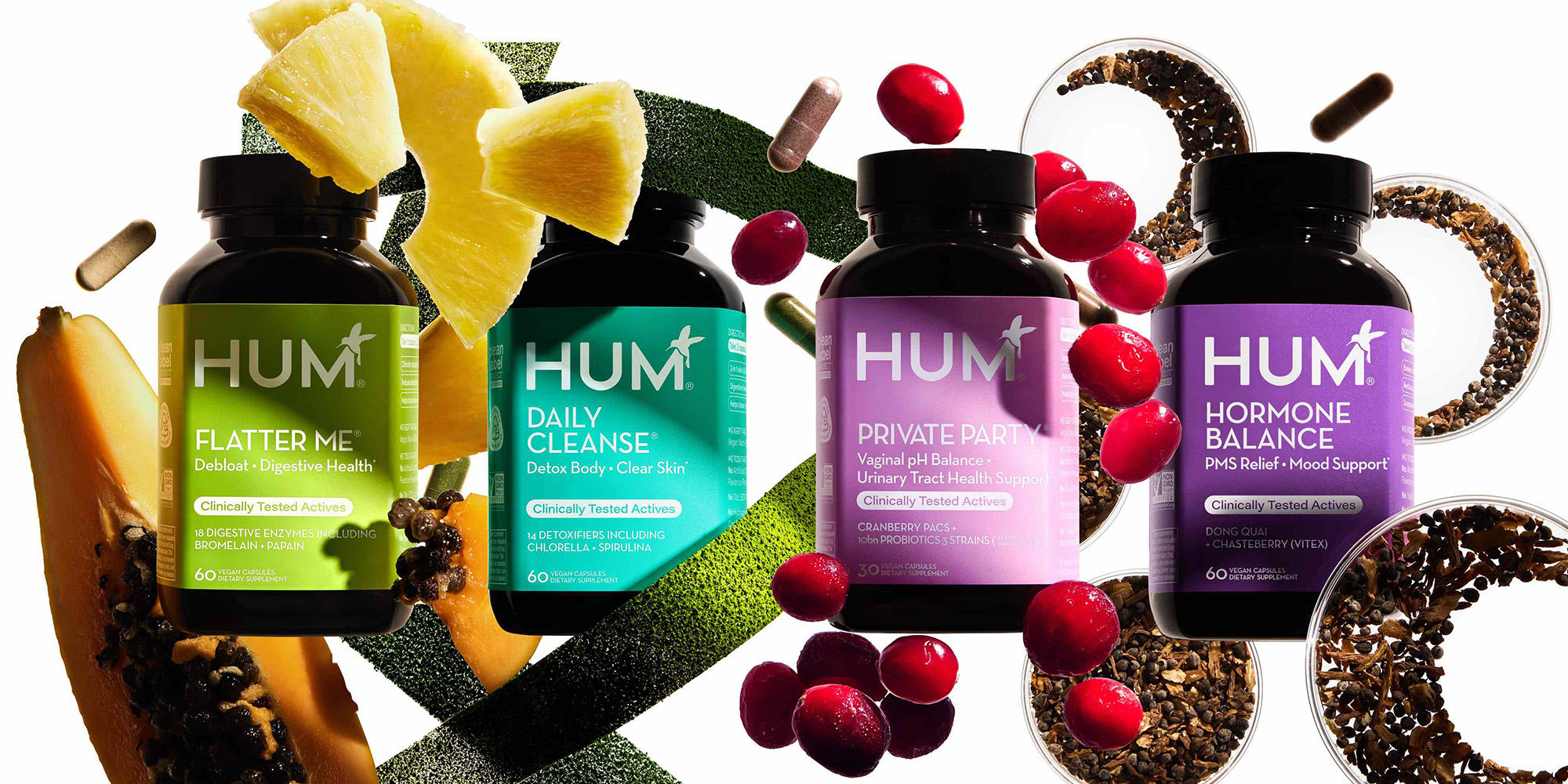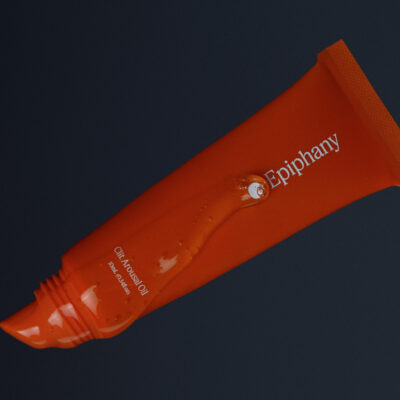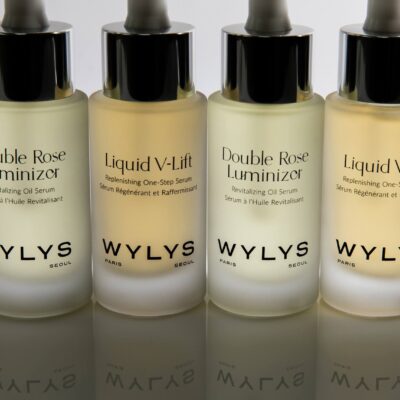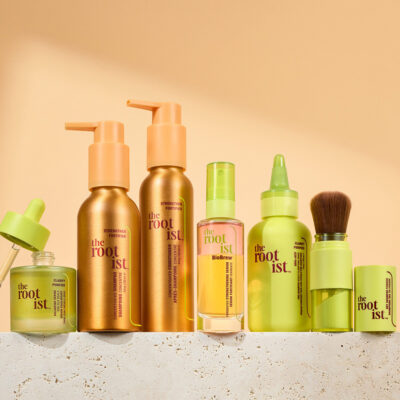
Why Hum Nutrition Shifted To The Mass Market
Nearly a decade ago, digitally native Hum Nutrition was a central figure in a wave of ingestible brands that entered prestige beauty retail. Prestige beauty retailers wanted in on a skyrocketing wellness category and saw ingestible products as no-brainer beauty merchandise adjacencies that its customers were already buying, albeit in other retail destinations. So far, however, their wellness forays haven’t been clear winners, although they continue to believe in the category and experiment with it.
Not every ingestible brand is up for waiting until prestige retailers pin down the right recipe for wellness. Hum Nutrition has shifted its retail distribution from prestige stores to the mass market. In April last year, it landed at Target with the products Beauty zzZz, Ashwagandha Calm, SOS PMS, Hyaluronic Glow and Hair Strong Gummies followed by Celery Juice Gummies in June. On Monday, Hum Nutrition’s Target presence was heightened with the arrival of its bestsellers Flatter Me, Daily Cleanse, Private Party and Hormone Balance as part of a nationwide rollout in the chain’s natural beauty sections. The brand expects the rollout to help it double its sales this year.
“We really want to meet the consumer where they are, whether it’s on our own website or with retailers such as Target and Amazon. We see no reason to be strong in only one,” says Walter Faulstroh, CEO and co-founder of 12-year-old Hum Nutrition. “Consumers should make that choice themselves. We just want to make it easier for them to shop Hum, which is why we moved from a DTC approach to an omni-channel approach.”
Beauty Independent talked to Faulstroh about the challenges prestige retailers face in the ingestible arena, product formats Hum Nutrition is exploring, the brand’s customer retention and messaging, wellness in its workplace, and trends he’s watching closely that will impact the business going forward.
What’s the backstory of the brand?
I dealt with acne quite a lot and was on Accutane three times. Then, my derm was putting me on Accutane for the fourth time, and during that time I had another company [V Water] in the U.K., which was vitamin-enhanced water. It was similar to Vitaminwater in the U.S., but it was focused on the European market. One of our formulators wrote a book about the importance of gut health vis-à-vis skin health. She was like, maybe I can help you figure out your skin through a different approach.
I worked with her, and we excluded certain food groups and included probiotics, cleansing herbs like milk thistle and algae by supplementation. I really saw great results. I was like, maybe there’s some other people out there who can benefit from a similar approach to skin health from the inside out. That’s how the company was born. And what was really interesting to me was having an expert at hand who can help you navigate the nutritional supplement space. So, we built this platform first where we connected consumers with nutritionists, and we also wanted to have a line of supplements that met our clean, clinical standards.
Fast forward a little bit, we became a success, and Sephora was really interested in what we’re doing. We launched first within Sephora [in 2016] and what became really evident is that our audience was predominantly female, 95% of them women are still women. We said, “Why don’t we really support this audience with innovation?” We ventured out from skin health to skin, body and mood health. Women’s health in general is a big topic for us as an organization.
What happened after that?
Lots of new brands have come to the market. The pandemic drove a lot of interest, especially in digital-native brands like Hum. We are now launching in retail on a wide scale. We were more on the prestige retail side, and now we’re going much more mass with the launch at Target. We are really focused on the wider distribution right now.
Have the prices changed?
We haven’t changed the price point. The SKUs going into Target are priced exactly the same way as they priced our website. That’s a testament to our brand. We can deliver great formulas that are clean and clinical at a very compelling price point that meets the Target criteria. For them, obviously value is very important. What we did is we started with gummies, and now we’re really building out the capsule collection. The gummies we price slightly lower, but purely based on count.

In prestige beauty retail, ingestibles have been difficult. What’s your take on that?
A few things. I think you really have to go fully behind the category. Obviously, some retailers are hugely successful with the category, and it’s just a question of creating education about the category and having enough offer plus I think a clear reason what the retailer stands for. A lot of prestige beauty retailers I would say are still very focused on their core business, which is color cosmetics and skincare, and I think for them it’s a bit harder to make that stretch because consumers are going into those retailers with a mindset of shopping that first.
But I think retailers who have clean standards in place, who are really thoughtful around basket building, offering something in addition and innovation to the consumer and having a consumer who obviously pays attention to wellness, I think they will win within the space, but it really comes down to making sure you have enough brands that are curated for the consumers.
How do you make your presence at Target successful?
Next year it really comes down supporting the retailer and building the demand, educating your audience about it. Remember, we are digitally native, and we have over 2 million people in our newsletter alone. It’s making sure our community knows you can now find us at Target stores. Target is a huge retailer, so you have to make sure you also educate your audience on where exactly to find you. There’s dedicated marketing to announce the launch, then also building the awareness around it and driving traffic, including at the point of sale and along with the promotional calendar.
What messages are resonating with consumers about Hum Nutrition products?
We did a lot of work around understanding the benefits Target guests are interested in and how you communicate those in ideally three to five words, really making the messaging concise, focusing on your hero SKU.
One of our hero products is Flatter Me. We did a clinical trial, which was double blind and placebo controlled, and the results were really compelling because you could see up to two inches less bloat after one use. It’s a strong message speaking to this immediate effect. Less bloat in one use is the message we’re communicating on shelf, which helps that consumer understand the product very quickly. Often, they’re time constrained, they’re distracted and have very other things in mind when they’re walking the aisles of the retailers. The second piece is having the right assortment, of course, understanding what the guest actually shops.
It feels like everybody is talking about longevity and drugs like Ozempic. What are you watching?
Ozempic and weight management is obviously a big topic. We launched a product called Best of Berberine. On TikTok, they call it nature’s Ozempic. It helps you manage glucose levels and reduce appetite. It also kills bad bacteria. It’s been a huge launch for us. We launched that recently because on the market you couldn’t really find a clean offering with the dosage that we found in most research, which was like 1,200 milligrams. There were some products, but they were lacking clean certification.
Everybody’s launching more and more innovation in the weight management space. So, I think that this conversation is just about to take off further. The question then becomes as a brand, is there a role for your product when people stop taking those medications to support their post-Ozempic journey?
When it comes to consumers, does being clean, sustainable or traceable move the needle?
You want to make sure there’s third-party certification, and we see [third-party certifier] Clean Label Project has definitely increased its awareness. We’ve seen more and more consumers understanding non-GMOs and giving credit for it. Ultimately, I think the most important piece is efficacy.
When the consumers research prior to purchasing, they get data points on how you formulate and why you formulate that way. If you can demonstrate that efficacy by a clinical trial, you are in a much better spot than other brands. They’re costly and not every brand has put as much thought into their formulas, and it’s more like ingredient focused versus formula focused to the extent they will go down the path of clinical trials.
Tell us about Hum Nutrition’s fundraising.
We raised $25 million for the business in total. I would say we’re on a bit more conservative side when it came to fundraising. We’re pretty self-sufficient. We don’t have to raise money another round, we’re in a good spot there. We always felt like we want to build a business that can sustain itself fairly swiftly.
What do you see in terms of M&A in your space in the CPG industry?
I don’t have any data points, but it feels like things are picking up again. They were a little bit quieter in 2023 than typical years prior to that, and it seems like that there’s suddenly a bit of an uptick now when it comes to transactions. I think brands that have a clear mission, a strong community and that have carved out a space for themselves are going to be in a good spot going forward, whether they’re going to be acquired or whether they’re going to grow on their own.
There’s a lot of noise in the market, too. I’ve seen a lot of brands come and go. Probably this is the result of people during the pandemic fundraising within health and wellness, and there were a lot of new brands. I think there’s going to be probably a bit of a shakeout in the industry in the next couple of years because there’s just too many brands coming to market to simply emulate what is out there already without having a clear point of difference.
What are marketing levers you are pulling?
We’re very focused on short-form video. It’s definitely a format that works well for us, and TikTok as a channel where gen Z does its research is really interesting to me. It’s basically what I would consider the search engine of the next generation. We have had pieces that got a lot of views, but we haven’t seen its full potential for the Hum brand.
The irony of the whole thing is what works quite well at the moment on TikTok are stills. Carousels are working quite well on TikTok, but, on Instagram, videos on Reels are taking off. These trends come and go and are platform dependent. Taking a step back and not being so platform focused, it’s really about being able to tell a very complex message in a way that’s engaging, yet educational. Building out this know-how within Hum is important to us, so we’ve been investing in teams there and thinking through who leads content.
We came to the conclusion that we want to be derived from the consumers’ lens first, their lifestyle, the way we can fit into their lives as opposed to simply talking about the product, which I think resonates less. We do it in short-form video, and we do it with more static posts, but also our blog, which still has a lot of traffic coming to it.
For example, we were one of the first to write about berberine on our blog, and we saw a lot of interest from our consumers. We actually took that insight and translated that into innovation on the product. So, we see content as a great way of getting in front of the audience, but also testing messaging and seeing what does resonate and informing our innovation process that way.

You mentioned clinical studies. How is your approach to research different than it might have been at the beginning of Hum Nutrition?
We just simply couldn’t have afforded clinical research. It ends up in the tens of thousands, the hundreds of thousands. On day one, we just didn’t have the funds to do so, but, the moment we did, we did invest in it. We have a VP of education and scientific affairs [Jennifer Martin-Biggers] at our company. She’s a PhD scientist, and there’s a team under her. When we do clinical research, we partner with labs, and they recruit the participants and make sure certain protocols are followed and the data is collected in an objective way.
The last research that we’ve did was the Flatter Me research I mentioned, but we did research on menopause to support a product called Fan Club, too. That was another area where we saw opportunity for the Hum brand to talk about topics that many brands didn’t really speak about or innovate in. We often pair consumer understanding with our innovation and research, and that’s led by internal team, but then we partner with third parties to actually conduct the clinical research.
Who is the Hum Nutrition customer?
We see her as somebody who’s obviously very interested in health and wellness. She’s in her late twenties, early thirties, but we also have obviously slightly older consumers and also gen Z. She has a workout routine, and she’s knowledgeable about health and wellness. She speaks to her friends about it as a bit of an authority herself within the space, but she also has a really fun attitude.
I think the Hum brand is really joyful and easy to engage with, and she’s not the kind of person who would probably lose sleep if she ate something unhealthy. She enjoys life, so she has a nice balance of being interested in space and leading a healthy lifestyle, but also having fun at the same time.
What product formats resonate with your customers?
Currently, we offer capsules, and capsules could be a soft gel, just a capsule or a tablet. We offer effervescents, powder and gummies. The majority of the business are the capsules followed by the gummies. Generally speaking, there are two types of consumers out there, some that don’t want any sugar whatsoever in their vitamins and they will go for the capsules, and others who just don’t like to swallow pills and they will have a hard time with those. They’ll go for the gummies.
The gummies are a great way into the space. There’s less of a friction point, and we have seen huge growth within gummies, particularly in the last couple of years. Having said that, we have seen growth throughout all the formats.
We looked at liquids. Often with liquids you have the issue of keeping the products stable, and taste is also an issue. To make a clinically potent dose, you have to put a lot of actives into the product, and if it’s something you can taste, it’s challenging. Plus, there’s a limitation when it comes to weight, and weight equals cost and carbon footprint.
We’re thinking through whether we could develop more powders. Currently, we have a green powder, and we have a protein powder, but we’re thinking, is there more space for powders in the product line? Then, there’s always a conversation about, should we go actually even broader and complement our ingestible formats with a topical format? We’ve seen some brands this, there’s nothing to announce right now, but these are the conversations that we’re having.
How long do people take your products?
The good news is we see retention metrics improve over time. Most of our consumers, they buy quite a lot of our products. It’s not like they purchase once, and they just disappear. Eighty percent of our business is from repeat. So, the vast majority of our revenue comes from customers who come back as opposed to customers who are just trying out something and then disappear.
What distribution opportunities do you see going forward for Hum Nutrition?
There’s just so much room still for us to grow as a business. Target is a great start within a wider distribution channel. That doesn’t mean it has to be last, but we’re really focused on that relationship right now. There are definitely opportunities within the natural channel, for example, where you can see the brand grow. This is just the beginning of a huge transformation where we are literally becoming a household name.
Obviously, Target is a big move for you, but what’s a smaller move you’ve made that has been really impactful?
What was really helpful was to bring the Amazon business in-house so we have more control over it. We worked in the past with third parties. It allowed us to control the service better that we’re delivering to the consumer, but also making sure we are on top of those resellers. And, as we are thinking of building that channel and how to invest and grow in it, we’re not held back by a lack of agility.
How do you see the international potential for your brand?
The U.S. is our core focus. We still think there’s so much room to grow in the U.S. and that’s really where the awareness is. There isn’t a day where somebody’s not telling me, “Oh, I would like to take your brand to Mexico. I want to take your brand to Brazil,” but we really came to the conclusion that we should stay focused for the time being and deliver the best product and best experience to U.S. consumers before we broaden the offering internationally.
In 2024, how much will the business be in DTC versus Amazon and retail?
We have a big concentration in DTC, but I think ideally I would say a third, a third, a third across those three channels.

How many people are on the team at Hum Nutrition, and what is the workplace structure?
Last time I checked we had 60 people on the team. We adopted a hybrid model. People come in a minimum of one day a week. I think it’s very important to have face time with the team, especially with ideas on creative campaigns or innovation. Information just tends to flow better when you’re sitting next to each other.
You are in the wellness space. How do you make sure that you and your team stay healthy?
It’s all about balance. Hydrate enough on a daily basis, do whatever form of exercise you like and connect. I think connection, the psychological piece, is so important. Then, obviously nurture your body with the right nutrients that you may need. I’m a strong believer in making it easy for people to participate in wellness as opposed to going to the extremes and only catering to a very small fragment.
We internally have lot of activities around that. For example, when I talk about coming to the office, it’s not just about being in the office, it’s about having that human connection. Sharing experiences with your co-workers makes your day-to-day so much better.
Positivity is one of our values as a company as well. So, on a weekly basis we call out accomplishments in front of every one in the team. Those little things make a big difference to people’s lives. In addition, we give our employees stipends for health and wellness to support them on their journey and put our money where our mouth is.
Your approach to wellness personally and with your team applies to a campaign Hum Nutrition is running this month. What’s that campaign?
The campaign is for people to participate in an easy health challenge and the overall umbrella is simplifying wellness and making it easier for people to participate in it. It can get quite complicated, but quite frankly it doesn’t have to be. That’s the message of the campaign, which I think will resonate not just our community, but also with the Target guest. That will be obviously activated by us, but also our influencer squad.
What are you watching that you think will have an effect on Hum Nutrition five to 10 years from now?
When you go to the website and you take the quiz, you’re connected to a nutritionist that you can consult with as much as you like. We offer this as a free service to our community. Those interactions are one-to-one, but they could be optimized using technology. There’s definitely room there from an educational and content perspective to drive that with more technology.
Then, on the innovation side, I always think, where do people actually spend money? So, a lot of money is being spent right now in glucose management. I would imagine we will be learning a lot about that space. I would say also, from an investment perspective, a lot of money is being raised in women’s health. So, we’ll see some incredible innovation there. Menopause is still one of those subjects that most people have very little education about. We are seeing OB-GYNs are getting better training and education because that’s still lacking.
The other big topic is the microbiome. Everybody always talks about Elon Musk going to Mars, but I like to look inside and go deep into the microbiome. There’s a lot of conversation about longevity and interesting research in that space, but for some reason I don’t think that’s an area where we will see the biggest breakthroughs. I may be wrong.




